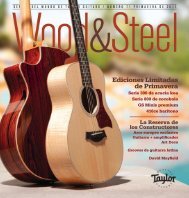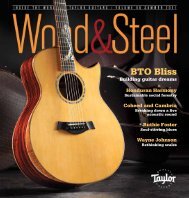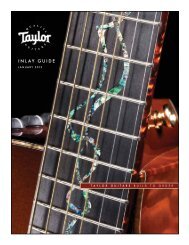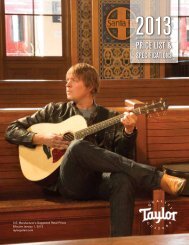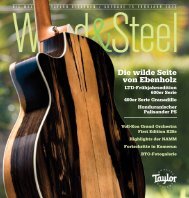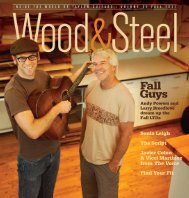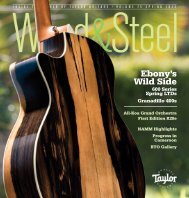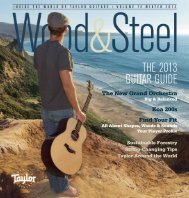Create successful ePaper yourself
Turn your PDF publications into a flip-book with our unique Google optimized e-Paper software.
The<br />
Fretboard<br />
Guitar theory may seem murky,<br />
but learning your way around<br />
the fretboard will give you<br />
the building blocks to<br />
express yourself<br />
By <strong>Shaw</strong>n Persinger<br />
Guitar Theory’s Rival:<br />
The Piano<br />
A major problem guitarists face<br />
when plunging into even the most basic<br />
rules of music theory is the convoluted<br />
way the guitar is laid out. For instance,<br />
there is no other instrument that has<br />
six different places to play the exact<br />
same note (Ex. 1, p. 27). In many ways,<br />
these multiple versions of E are a true<br />
blessing for a guitarist when playing,<br />
but when it comes to theory they just<br />
cloud the issue. The piano is the music<br />
theorist’s best friend; the guitar plays<br />
runner-up.<br />
I’m not suggesting you all drop<br />
your <strong>Taylor</strong>s and start subscribing to<br />
Steinway Monthly. On the contrary, I’ll<br />
show you how to take advantage of<br />
the guitar’s unusual layout. However,<br />
I would recommend that if you have<br />
access to a keyboard (and given the<br />
fact that most toy stores carry miniature<br />
pianos for as little as $10, there is no<br />
excuse not to), then you might doublecheck<br />
your theory work by referring<br />
to the keyboard. Let’s start here and<br />
demonstrate some of theory’s most<br />
basic principles by comparing the<br />
different points of view of a pianist and<br />
a guitarist.<br />
On the keyboard, basic theory<br />
is usually discussed in the key of C.<br />
This is because all the white keys on<br />
the piano are pitches in the key of C.<br />
This makes naming the pitches easy<br />
(Ex. 2), naming the intervals easy (Ex.<br />
2), and even playing chords easy. The<br />
F chord is no harder to play on the<br />
piano than the E minor (Ex. 3 and 4).<br />
Are you starting to second-guess your<br />
instrument choice yet?<br />
Ex. 2: Note names and intervals<br />
For some guitar players, the idea<br />
of music theory might conjure<br />
images of white-wigged old<br />
men hunched over writing desks and<br />
scribbling madly on parchment paper —<br />
an activity more akin to math professors<br />
than rock stars. But any musician worth<br />
his salt knows some music theory,<br />
whether he realizes it or not. Knowing<br />
that a G chord is called a G chord<br />
is music theory! You don’t have to<br />
know that a G chord is made from the<br />
pitches G, B and D; that’s just slightly<br />
more advanced theory. Counting off<br />
a song, “1, 2, 3, 4!” is music theory.<br />
That count establishes a rhythm of<br />
4/4. You don’t need to know that each<br />
measure can be subdivided into smaller<br />
groups of twos and threes or filled<br />
up with eighth notes, triplets or rests.<br />
That is simply more advanced theory.<br />
You probably know other theoretical<br />
concepts, too, and either don’t realize it<br />
or have trouble explaining it, especially<br />
on your instrument of choice.<br />
You see, the guitar fretboard’s<br />
layout is not a logical one. This is<br />
because the guitar has evolved over<br />
thousands of years (the so-called<br />
“Hittite Guitar” dates back to roughly<br />
1300 B.C.), and as a result, the<br />
playable functions started for practical<br />
rather than logical purposes. In other<br />
words, they sounded good, so they<br />
didn’t have to be mathematically valid.<br />
Unlike the piano, which was designed<br />
to perform as the ultimate reasonable<br />
and coherent instrument, the guitar is<br />
more of a wild animal that has been<br />
tamed to a point, yet still preserves its<br />
feral nature, which can cause it to bite<br />
in the most unexpected and irrational<br />
ways.<br />
If you’ve ever felt the sharp teeth<br />
of the guitar’s design gnawing into<br />
your understanding of what you are<br />
technically doing when you play your<br />
favorite songs, you are not alone. So,<br />
just relax and get ready to fill in some<br />
blanks in your constantly growing<br />
knowledge of the guitar, music and its<br />
underlying principles.<br />
Ex. 3: E minor chord<br />
Ex. 4: F chord




